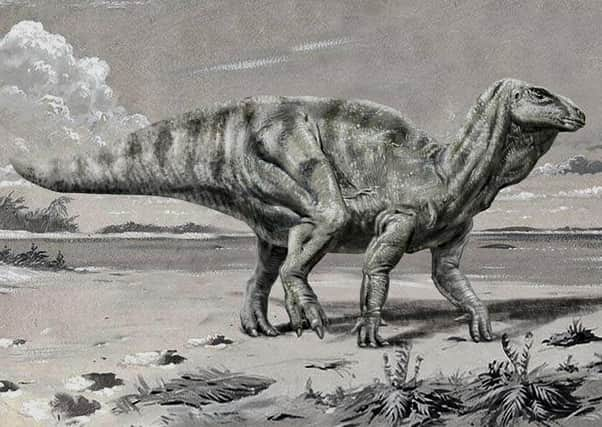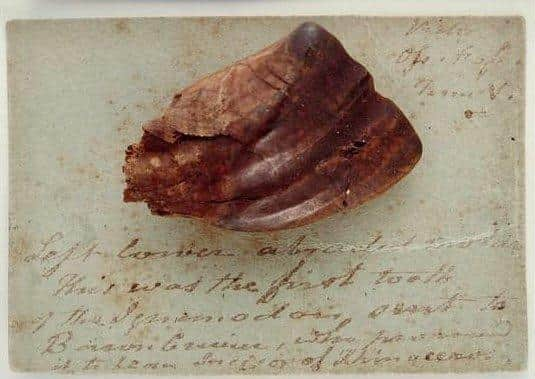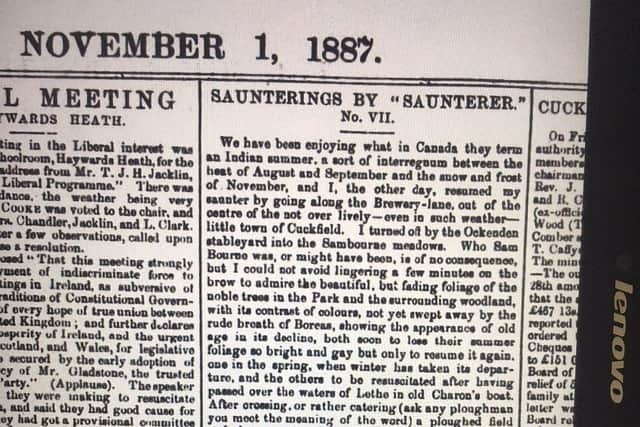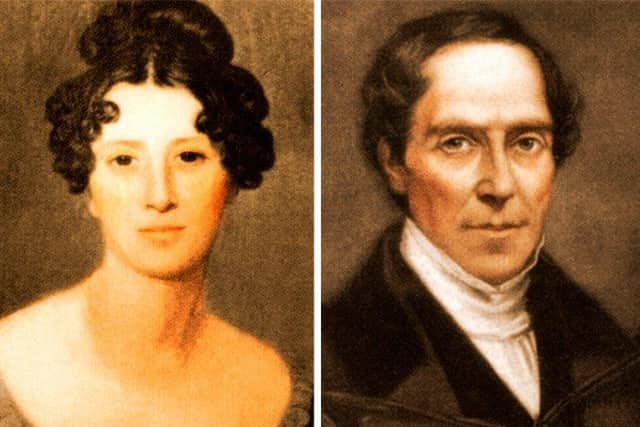Details of dinosaur discovery in Cuckfield are a ‘hugely significant’ find


Martin Simpson came across an article published by this newspaper in 1887, penned by the ‘Saunterer’ which refers to the finding of the dinosaur’s teeth in Cuckfield.
The discovery is credited to Dr Gideon Mantell and the dinosaur was formally named in 1825.
Advertisement
Hide AdAdvertisement
Hide AdMr Simpson says the article substantiates the classic story that it was Gideon’s wife Mary Ann Mantell who found the worn-down teeth in some rocks by the roadside, while her husband was elsewhere.


He said that version of events had been doubted by scholars over the years who suggested the teeth were in fact found by her husband, a quarryman or intermediary, and Mary had not been given due credit for her involvement.
He said: “She was accompanied by a friend and purchased the specimens from a workman. We now have the ‘who, what, where and why’ in this discovery, but the precise ‘when’ remains unclear.
“It is suggested in this article that the event took place on 21 May 1821 and the fossils were passed to Gideon the following day.
Advertisement
Hide AdAdvertisement
Hide Ad“Subsequently, the ‘later to be’ dinosaur was formally named in 1825.”


Mr Simpson, who lives on the Isle of Wight, said lockdown had given him more time to prepare, catalogue and research fossils, and he had been trawling the internet for obscure references to check out species of interest and add to their historical background.
As a result, he came across ‘something completely unexpected, previously overlooked and hugely significant’.
“We have a provincial genealogist to thank for posting an article online about some early nineteenth-century inhabitants of a quintessentially English country village called Cuckfield, in the sleepy and picturesque county of West Sussex,” he said.
Advertisement
Hide AdAdvertisement
Hide Ad“In his blog Cuckfield Connections, Mr Andy Revell has shone new light upon a story of immense importance to those interested in the history of palaeontology, in particular the study of dinosaurs.


“This is because one of the characters referred to is Mary Ann Mantell, wife of the famous surgeon and fossil collector, Gideon Algernon Mantell, a pioneer of Cretaceous palaeontology.
“There is an often-told story in palaeontology of how, in the early 1820s, the first fossilised teeth were found of a creature later to be named Iguanodon, a giant terrestrial ‘saurian’ or reptile.
“This was later still to be included in a select group of creatures, christened the Dinosauria by Richard Owen in 1842.
Advertisement
Hide AdAdvertisement
Hide Ad“The traditional version of this tale, endlessly repeated in dinosaur books, articles and magazines across the world is that Mrs Mantell was out walking by the roadside while her husband Gideon was attending a patient in Cuckfield, and that she happened to come across (in a pile of rubble) some unusual fossilised wedge-shaped teeth.
“Upon seeing these specimens, so the story goes, Gideon realised that the worn down and ostensibly mammal-like teeth belonged instead to a giant herbivorous reptile, a creature new to science which, in February 1825, he formally named Iguanodon.”
The Mid Sussex Times article, though written some years after the discovery, backs up this original story that it was Mary who discovered the teeth.
The extract from Tuesday November 1, 1887, posted online by Mr Revell, says: “Mrs. Mantell, wife of Sir Gideon, then a surgeon at Lewes, being on a visit to her friend Mrs. Waller, wife of Mr S.Waller, solicitor, of Cuckfield, the two ladies on walking over the green passed by a man by the roadside breaking lumps of stones; when Mrs Mantell, perceiving what appeared to be a fossil on one of the stones, they stayed to examine it, and being satisfied of its nature gave the man a gratuity to take it to Mrs Waller’s house, from whence Mrs Mantell took it home for her husband’s inspection.”
Advertisement
Hide AdAdvertisement
Hide AdIt goes on to detail how after seeing the teeth, Gideon went to the pit himself and paid the men excavating the area to preserve any fossils they found for him.
Mr Simpson said there was evidence that Mary contributed greatly to her husband’s work over the years, but they later had an acrimonious separation.
“Gideon instructed his son Walter to delete any journal entries referring to his wife on the event of his death (1852), and there is no doubt that he was bitter about the breakup of his marriage for the rest of his life,” he added.
Mr Simpson said Gideon could be ‘unreliable in recording his fossil discoveries and his accounts are sometimes inaccurate’.
Advertisement
Hide AdAdvertisement
Hide Ad“Regardless of any resentment or animosity arising from the separation, it is unfair that Mary has not received due credit for her palaeontological contributions.
“Descriptions of the story as charming or fanciful made by (mostly) male writers, although somewhat patronising, must be seen in the context of geology traditionally being a male-dominated science.
“That it was a woman who made such a significant palaeontological discovery in Regency England is remarkable considering its patriarchal society, her contribution ranking alongside those made by other exceptional contemporary females such as Mary Anning of Dorset or Etheldred Benett of Wiltshire.
“In my opinion, the most important thing is not that the teeth fell into Gideon’s hands (Norman 1985), but that the true version of events is well documented and Mary receives the credit she deserves.”
Advertisement
Hide AdAdvertisement
Hide AdHe added: “Mary’s involvement in the story of the discovery of Iguanodon may well have been gradually written out of history, had it not been for Mr Revell’s chance rediscovery of this article from the Mid Sussex Times of 1887, a “Revelation” indeed.”